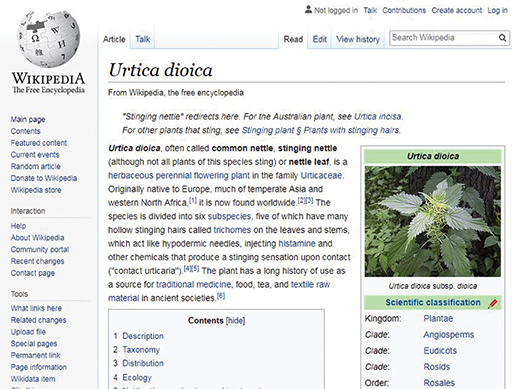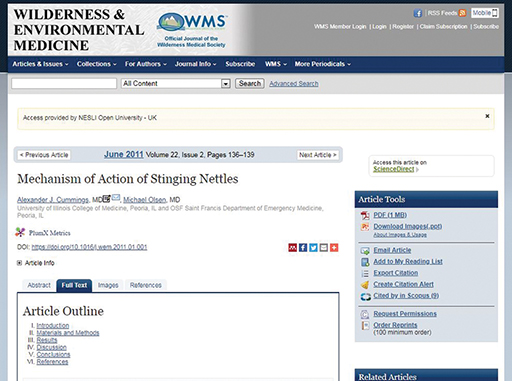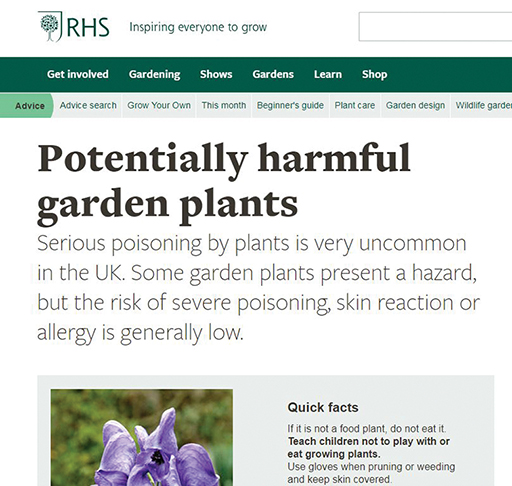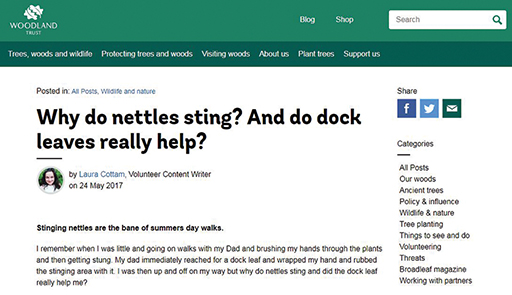4.1 More examples
Knowing that anyone can edit Wikipedia, I decided to follow up some links to articles about the use of nettles for textiles. At the bottom of the Wikipedia page (Figure 6), there is a list of references, where you can find out the original source of the information quoted.
I clicked on the link to an article in the Guardian newspaper from 2008 claiming that stinging nettles have been historically used to make textiles with, and provide an eco-friendly alternative to cotton: www.theguardian.com/environment/2008/feb/28/ethicalliving.fashion . A search for ‘Urtica dioica textiles’ in Google Scholar (a facility provided by Google to search academic literature including publications in journals and books) reveals many articles about the use of the stinging nettle for making cloth.
Curiosity about how nettles may be used locally, including possible links to food, nutrition and health, led me to explore cookery websites, including the leading food website BBC Good Food, which had a recipe for nettle soup [Tip: hold Ctrl and click a link to open it in a new tab. (Hide tip)] .
However, despite finding all this information, I was still worried about the possible impact of nettle stings. I resolved to find out how the sting works and possible remedies, so consulted the Wilderness & Environmental Medicine Journal, a reputable professional magazine. From its website I learned that nettles have a physical and chemical action that lacerates and then irritates the skin (Figure 8).
So now I knew the science behind a nettle sting, but is there anything that can be done to treat it? I looked back at the Wikipedia page and found a reference to dock leaves for treating nettle stings. I followed up the link in the references at the bottom of the Wikipedia web page which took me to a primary school activity page about nettle stings and some interesting experiments relating to their treatment (Figure 8).
I also found that the Woodland Trust had some useful information, answering questions about the use of dock leaves to alleviate symptoms. I’m not brave enough to try it right now, but the next time I happen to get stung, I will try using them and share my experience! See the Woodland Trust website for more information on this (Figure 9).
I then decided to search for ‘nettle sting’ on the NHS (the UK’s National Health Service) website to see what the current medical advice was. There was no mention of dock leaves, but instead it advises that the rash will settle quickly and recommends speaking to a pharmacist about anti-histamine tablets. So it seems that there are potentially some myths around the use of dock leaves, but I wanted to have a final look into this. I went back to the article in the Wilderness & Environmental Medicine Journal to see if there was any mention of dock leaves. They suggest that dock leaves (and other plants) might help with nettle stings by reducing the biochemical impacts, but they can’t do anything to reduce the mechanical impacts of a nettle sting on the skin.
Activity 2 Doing your own search
Having read the example search given in this section, do your own search by first selecting one of the following species:
- Bewick’s swan (Cygnus columbianus)
- Hedgehog mushroom (Hydnum repandum)
- Brown trout (Salmo trutta)
Attempt to answer the following questions by doing similar searches to those described in this section. Where possible, also explore the interactions of the species with others.
- Where does the species live? Can you find a distribution map showing which parts of the world the species is found in, and does it live there all year round?
- Do people eat the species and, if so, in which parts of the world is it commonly eaten?
- To which family does the species belong?
Answer
- Distribution maps for each species:
- a.Bewick’s swan (Cygnus columbianus). Note that the Bewick’s swan migrates between the Arctic, where it breeds, and various areas further south, where it escapes the cold winters and lack of food.
- b.Hedgehog mushroom (Hydnum repandum).
- c.Brown trout (Salmo trutta). Note that there are forms of Salmo trutta that migrate while other forms remain in lakes or rivers.
- The Bewick’s swan (Cygnus columbianus) is shot for food, even though in most of its range it is illegal to kill it. The hedgehog mushroom (Hydnum repandum) is widely eaten in Europe and North America. The brown trout (Salmo trutta) is commonly farmed and is a popular species for recreational fishing.
- The Bewick’s swan (Cygnus columbianus) belongs to the Anatidae family. The hedgehog mushroom (Hydnum repandum) belongs to the Hydnaceae family. The brown trout (Salmo trutta) belongs to the Salmonidae family. Note, however, that taxonomy is in a continuous state of flux and terms relating to family, genus and species may change as new information becomes available.
Of course, you might want to go beyond this suggested activity and find answers to other questions you have about your chosen species. Often the more answers you find, the more questions you have!




